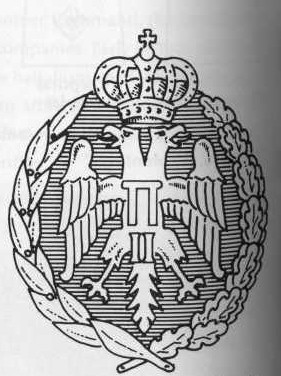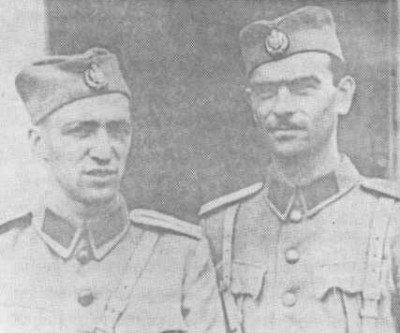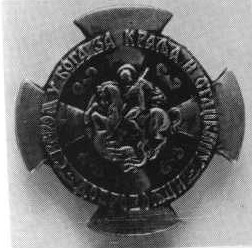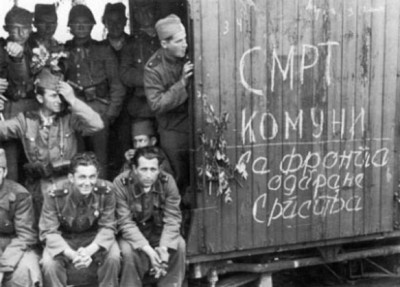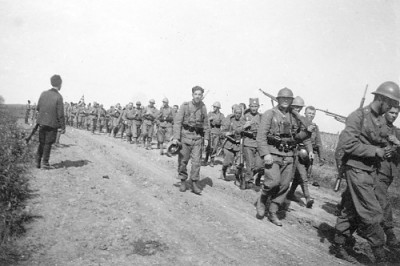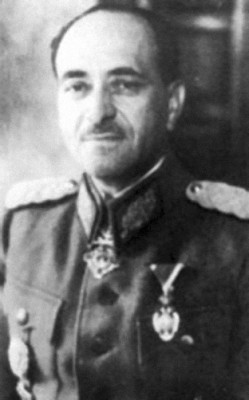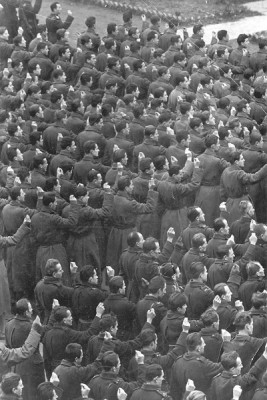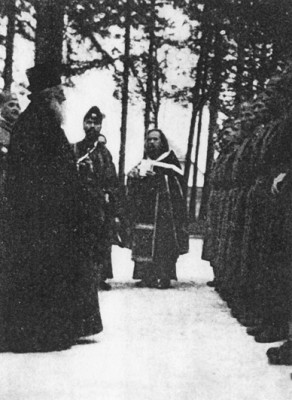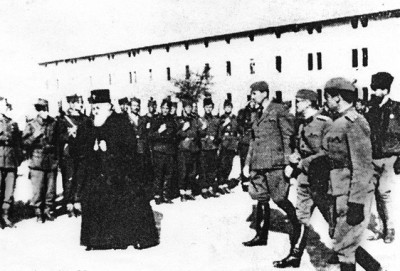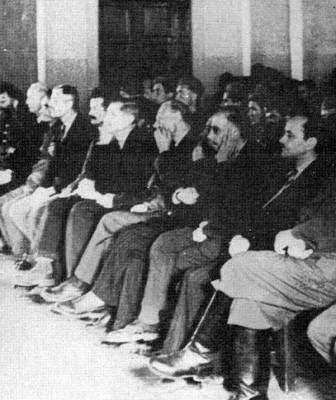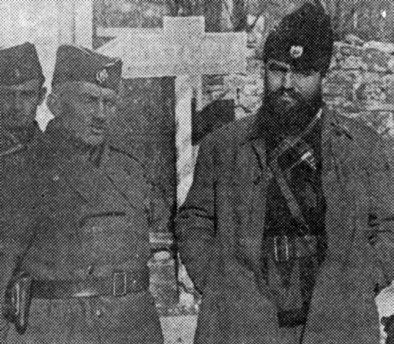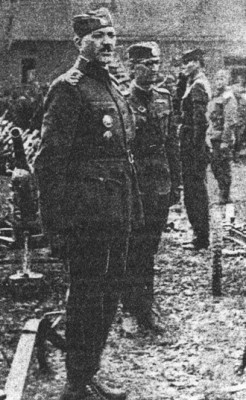Serbisches SS Korps
The Serbs, unlike other "Yugoslav" nationalities, collaborated with the Germans to a very small extent. This was, of course, primarily due to the German attitude towards the Serbs as Slavs, as well as Hitler's geopolitical theory of the dismemberment of Serbia (including weakening the Serbian nation and "turning a blind eye" to the genocide being carried out on them) and the creation of the states of Greater Hungary, Greater Albania, etc. - see my article here for more on this Hitlerian strategy.
However, given Great Britain's strong power ambitions in the Balkans (including political interventions, influence, etc.) and its desire to drag Yugoslavia, or at least part of it, into the fight against Germany, along with the strong danger of communism, a certain section of Serbs saw a way out of this dangerous situation by siding with a strong partner that would guarantee Serbia's security.
For this reason, during the occupation of Serbia (although it is probably more appropriate to name this period of Serbian history as a protectorate - similarly to the Czechoslovakia, Serbia had a more or less puppet government with Prime Minister Milan Nedic, former commander-in-chief of the Royal Yugoslav Army), a small number of units were formed - among the most prominent ones, Srpska Državna Straža (Serbian State Guard, S.D.S.), Srpska Granična Straža (Serbian Border Guard, S.G.S.) and Srpski Dobrovoljački Korpus (Serbian Volunteer Corps, S.D.K.), German: Serbisches-Freiwilligen-Korps).
For our discussion of SS units, the last mentioned group, the S.D.K., is thus particularly important. These first units, still independent of the SS, were formed in Belgrade on 15 September 1941 as the Srpska Dobrovoljacka Komanda (known in German as the Serbisches-Freiwilligen-Abteilung) - more precisely in 12 commando units (each roughly 120-150 men). Later (20 November 1942) there was an increase in men to a total of 3,685 (of which 172 were officers), and this process was completed in January 1943 with the growth of interested parties and with the expansion of powers and also the actions of Serbian partisans (both communist and nationalist - especially royalist - e.g. Chetniks), when it was reorganized into the Srpska Dobrovoljacki Korpus (Serbisches-Freiwilligen-Korps) - the unit was composed of 5 battalions (each with three companies). This unit also became part of the German units, as each of their battalions was subordinated to one of the German battalions. Likewise, this corps fell under the military jurisdiction of the German Army.
The personnel of this unit consisted mainly of members of the pre-war strongly nationalist party (strongly religious) known as Sbor (Serbian: Zbor, founded on 6 January 1935) or its youth organization, the Beli Orli (White Eagles). They were also very often called Ljoticevci after their leader and founder of the Sbor, Dimitrije Ljotić (former Minister of Justice, 1931, in the government of Petar Živković, from which he left after the King rejected his draft constitution, which at this time contained very modern elements such as equal, secret suffrage).
Ljotić is also significant for the history of Serbia in WW II because he contacted Chetnik leader Draž Mihajlović, and through his assistance the Chetniks were given food and relief in military attacks against these groups. Such rapprochement eventually led to the Chetniks ceasing most of their actions against Germany in 1943 and instead focusing solely on fighting the communist guerrillas, leading to a change in preference on the Allied side. At the Tehran Conference, support for the Serbs was reassessed and the main "horse" of the Allies (and the British Special Operations Department !!) became Tito and his communist partisans. Again, as in most cases of such interference in the reality of the Balkans, it led to the creation of the communist state of Yugoslavia and later to the Balkan wars.
However, back to the unit - in 1944 the five battalions are expanded to 5 regiments (each with 3 battalions, except the 5th regiment which had only 1) and an artillery "division" of only 500 men was attached The headquarters of each regiment then became the following regions - 1st regiment near Valjevo, 2nd regiment near Kragujevac, 3rd regiment near Shapts, 4th regiment near Smederevo, 5th regiment near Krushevac. These regiments were supplied with equipment, armaments, food from the Serbian government as well as from the German occupation authorities.
The headquarters of each regiment then became the following regions - 1st regiment near Valjevo, 2nd regiment near Kragujevac, 3rd regiment near Shapts, 4th regiment near Smederevo, 5th regiment near Krushevac. These regiments were supplied with equipment, armaments, food from the Serbian government as well as from the German occupation authorities.
With the expansion of this army it also came to the point that the knowledge and experience of someone with war experience was required, for this reason Ljotic was pushed even further out of his role in the S.D.K. by other commanders (see more in the Commanders section). In 1944 it was mainly Kosta Mušicki, Micašević, Petrović, etc... When the Red Army liberated most of the Serbian territory in the spring of 1944, the S.D.K. (together with other Serbian units) were evacuated to Slovenia (together with Slovenian nationalists they planned to restore the Yugoslav monarchy). More precisely, these pro-German units left Belgrade on 8 October 1944, heading first for Syria. Only from there did they then head further north into Slovenia.
However, while passing through Croatian territory, some of the units meet with tragedy when they engage Pavelić's Ustaše, and some units are captured. As fighters against Croatian independence and supporters of Greater Serbia, their members are immediately executed by the Ustaše.
Peace for the unit comes only when they reach Slovenia, where they reach a German fortified base in the town of Slovenj Gradec (Slovene Hradec). However, heavy fighting around Belgrade with communist partisans, retreat through Croatian territory and fighting on Slovenian territory took a heavy toll - the unit now numbers only 3,000 men (so the losses of this unit are about 7,000 men !!).
Most of these Serbian and Slovenian units are then placed under the wings of the Waffen-SS, which by this time already had a monopoly on all foreign units fighting on the side of Germany - for the S.D.K. it is precisely on 27 November 1944 that they become part of the Waffen-SS. Along with this, the Serbisches-Freiwilligen-Korps is reorganized - a liaison platoon, engineers, a mountain supply detachment, a staff company (members of the German minority), and a certain portion of the roughly 20,000 men of the Slovenian Home Guard and Slovenian Border Guard (evacuated from Istria) are added, as well as the scattered remnants of some Serbian Chetniks and released Serbian prisoners of war. The individual regiments are then deployed as follows - the 1st Regiment near Postojna, the 2nd Regiment near Pivka, the 3rd Regiment near Musica, the 4th Regiment near Ilirskoi Bistrica, and the last 5th Regiment near Prem. The Serbian Corps thus fell under the command of SS-Gruppenführer and Generalleutnant der Polizei Odilo Globočnik. The total number of men in the corps at this time is estimated at about 8,000 men.
Since this fact of the S.D.K. falling under the Waffen-SS is largely rejected, especially in some Serbian literature, I will quote part of the order making this unit part of the SS (original quote from OKH document - "GenStdH/Org.Abt. Nr.II/47133/44 g.Kdos." dated 27 November 1944):
"Das Serbische Freiwilligen-Korps (einschl.Nachr.Kp. und Geb.Nachschub-Kol.Abt.) mit dazugehörigem deutschen Verbindungsstab für Korpsstab, 5 Rgter., 15 Btle., wird in seiner derzeitigen personellen und materiellen Zusammensetzung mit sofortiger Wirkung in jeder Beziehung dem Reichführer SS unterstellt und in die Waffen-SS versetzt."
In the same year, 1944, after more fierce fighting with the partisans and the advancing Red Army, this unit is promoted to Serbisches SS Korps, but there is no record of its members wearing SS uniforms, SS ranks, or other trappings of Waffen-SS combat units.
Due to the worsening situation on the Yugoslav front, another reorganization takes place - the corps is affiliated to its former enemies on 30 April 1945 - more precisely to the Chetnik division, the so-called Šumadia Division, by order of General Damjanović, commander of General Mihajlović's army, the so-called "Yugoslav Army", at that time stationed in Slovenia. That is, the same Mihajlovic with whom Ljotić had been negotiating since 1941 and had made possible the survival of his troops.
This reorganization is fully in line with the 1945 Waffen-SS reform, which saw the creation of national armies of non-German nations - e.g. KONR, UNA, East Turks Battalion, etc. The unit was also under the command of SS-Obergruppenführer Roesner.
Later on 1 May 1945, two of the regiments (namely the 1st and 5th Regiments) crossed the border into Italy and briefly fought the Allies - here they were also captured on 29 April near the town of Palmanova, about 60 km from Trieste (about 2,400-2,800 men). The other three regiments, after fighting hard with the partisans around the vicinity of Ljubljana (Ljubljana) to prevent them from entering that city, retreated further north into Austria (towards Graz). Here they surrendered to the British at the town of Unterbergen on the Drava River on 12 May 1945, but were immediately handed over to Tito's Communist partisans. These remaining 1,000 Chetniks, about 5,000 men from the SS Korps and another 10,000 men of the Slovenian Home Guard captured around Ljublana were then either executed immediately in the Gottschee forest, or were further transported to a camp near the town of Světi Vid (near Ljublana), or in Kocevje Rog, where they were tortured and shot after some time.
The two regiments that surrendered to the British in Italy were not surrendered and their men survived.
As far as the main protagonists of this corps are concerned, especially Dimitri Ljotic and Kosta Musicky, their fate was different.
Dimitri Ljotic died in a car accident on 22 April 1945, when he was returning to his troops after meeting with Hitler's envoy for the Balkans, Neubacher, to discuss the possible surrender of the SS Korps to the Allies. He crossed the bridge at night, but it had already been attacked by Allied fighters in the evening and was heavily damaged. During the night, Ljotic failed to notice this fact and his car fell through one of the holes in the bridge. Ljotic himself broke his neck when his car fell into the ravine.
Kosta Mušicki was captured in Italy and in 1946 he was handed over to the Yugoslav court, where in the trial of the main protagonists of the collaboration with the Germans, i.e. the Chetnik leader D. Mihajlović, etc., he was sentenced to death, which was subsequently carried out.
The Serbs, unlike other "Yugoslav" nationalities, collaborated with the Germans to a very small extent. This was, of course, primarily due to the German attitude towards the Serbs as Slavs, as well as Hitler's geopolitical theory of the dismemberment of Serbia (including weakening the Serbian nation and "turning a blind eye" to the genocide being carried out on them) and the creation of the states of Greater Hungary, Greater Albania, etc. - see my article here for more on this Hitlerian strategy.
However, given Great Britain's strong power ambitions in the Balkans (including political interventions, influence, etc.) and its desire to drag Yugoslavia, or at least part of it, into the fight against Germany, along with the strong danger of communism, a certain section of Serbs saw a way out of this dangerous situation by siding with a strong partner that would guarantee Serbia's security.
For this reason, during the occupation of Serbia (although it is probably more appropriate to name this period of Serbian history as a protectorate - similarly to the Czechoslovakia, Serbia had a more or less puppet government with Prime Minister Milan Nedic, former commander-in-chief of the Royal Yugoslav Army), a small number of units were formed - among the most prominent ones, Srpska Državna Straža (Serbian State Guard, S.D.S.), Srpska Granična Straža (Serbian Border Guard, S.G.S.) and Srpski Dobrovoljački Korpus (Serbian Volunteer Corps, S.D.K.), German: Serbisches-Freiwilligen-Korps).
For our discussion of SS units, the last mentioned group, the S.D.K., is thus particularly important. These first units, still independent of the SS, were formed in Belgrade on 15 September 1941 as the Srpska Dobrovoljacka Komanda (known in German as the Serbisches-Freiwilligen-Abteilung) - more precisely in 12 commando units (each roughly 120-150 men). Later (20 November 1942) there was an increase in men to a total of 3,685 (of which 172 were officers), and this process was completed in January 1943 with the growth of interested parties and with the expansion of powers and also the actions of Serbian partisans (both communist and nationalist - especially royalist - e.g. Chetniks), when it was reorganized into the Srpska Dobrovoljacki Korpus (Serbisches-Freiwilligen-Korps) - the unit was composed of 5 battalions (each with three companies). This unit also became part of the German units, as each of their battalions was subordinated to one of the German battalions. Likewise, this corps fell under the military jurisdiction of the German Army.
The personnel of this unit consisted mainly of members of the pre-war strongly nationalist party (strongly religious) known as Sbor (Serbian: Zbor, founded on 6 January 1935) or its youth organization, the Beli Orli (White Eagles). They were also very often called Ljoticevci after their leader and founder of the Sbor, Dimitrije Ljotić (former Minister of Justice, 1931, in the government of Petar Živković, from which he left after the King rejected his draft constitution, which at this time contained very modern elements such as equal, secret suffrage).
Ljotić is also significant for the history of Serbia in WW II because he contacted Chetnik leader Draž Mihajlović, and through his assistance the Chetniks were given food and relief in military attacks against these groups. Such rapprochement eventually led to the Chetniks ceasing most of their actions against Germany in 1943 and instead focusing solely on fighting the communist guerrillas, leading to a change in preference on the Allied side. At the Tehran Conference, support for the Serbs was reassessed and the main "horse" of the Allies (and the British Special Operations Department !!) became Tito and his communist partisans. Again, as in most cases of such interference in the reality of the Balkans, it led to the creation of the communist state of Yugoslavia and later to the Balkan wars.
However, back to the unit - in 1944 the five battalions are expanded to 5 regiments (each with 3 battalions, except the 5th regiment which had only 1) and an artillery "division" of only 500 men was attached
With the expansion of this army it also came to the point that the knowledge and experience of someone with war experience was required, for this reason Ljotic was pushed even further out of his role in the S.D.K. by other commanders (see more in the Commanders section). In 1944 it was mainly Kosta Mušicki, Micašević, Petrović, etc... When the Red Army liberated most of the Serbian territory in the spring of 1944, the S.D.K. (together with other Serbian units) were evacuated to Slovenia (together with Slovenian nationalists they planned to restore the Yugoslav monarchy). More precisely, these pro-German units left Belgrade on 8 October 1944, heading first for Syria. Only from there did they then head further north into Slovenia.
However, while passing through Croatian territory, some of the units meet with tragedy when they engage Pavelić's Ustaše, and some units are captured. As fighters against Croatian independence and supporters of Greater Serbia, their members are immediately executed by the Ustaše.
Peace for the unit comes only when they reach Slovenia, where they reach a German fortified base in the town of Slovenj Gradec (Slovene Hradec). However, heavy fighting around Belgrade with communist partisans, retreat through Croatian territory and fighting on Slovenian territory took a heavy toll - the unit now numbers only 3,000 men (so the losses of this unit are about 7,000 men !!).
Most of these Serbian and Slovenian units are then placed under the wings of the Waffen-SS, which by this time already had a monopoly on all foreign units fighting on the side of Germany - for the S.D.K. it is precisely on 27 November 1944 that they become part of the Waffen-SS. Along with this, the Serbisches-Freiwilligen-Korps is reorganized - a liaison platoon, engineers, a mountain supply detachment, a staff company (members of the German minority), and a certain portion of the roughly 20,000 men of the Slovenian Home Guard and Slovenian Border Guard (evacuated from Istria) are added, as well as the scattered remnants of some Serbian Chetniks and released Serbian prisoners of war. The individual regiments are then deployed as follows - the 1st Regiment near Postojna, the 2nd Regiment near Pivka, the 3rd Regiment near Musica, the 4th Regiment near Ilirskoi Bistrica, and the last 5th Regiment near Prem. The Serbian Corps thus fell under the command of SS-Gruppenführer and Generalleutnant der Polizei Odilo Globočnik. The total number of men in the corps at this time is estimated at about 8,000 men.
Since this fact of the S.D.K. falling under the Waffen-SS is largely rejected, especially in some Serbian literature, I will quote part of the order making this unit part of the SS (original quote from OKH document - "GenStdH/Org.Abt. Nr.II/47133/44 g.Kdos." dated 27 November 1944):
"Das Serbische Freiwilligen-Korps (einschl.Nachr.Kp. und Geb.Nachschub-Kol.Abt.) mit dazugehörigem deutschen Verbindungsstab für Korpsstab, 5 Rgter., 15 Btle., wird in seiner derzeitigen personellen und materiellen Zusammensetzung mit sofortiger Wirkung in jeder Beziehung dem Reichführer SS unterstellt und in die Waffen-SS versetzt."
In the same year, 1944, after more fierce fighting with the partisans and the advancing Red Army, this unit is promoted to Serbisches SS Korps, but there is no record of its members wearing SS uniforms, SS ranks, or other trappings of Waffen-SS combat units.
Due to the worsening situation on the Yugoslav front, another reorganization takes place - the corps is affiliated to its former enemies on 30 April 1945 - more precisely to the Chetnik division, the so-called Šumadia Division, by order of General Damjanović, commander of General Mihajlović's army, the so-called "Yugoslav Army", at that time stationed in Slovenia. That is, the same Mihajlovic with whom Ljotić had been negotiating since 1941 and had made possible the survival of his troops.
This reorganization is fully in line with the 1945 Waffen-SS reform, which saw the creation of national armies of non-German nations - e.g. KONR, UNA, East Turks Battalion, etc. The unit was also under the command of SS-Obergruppenführer Roesner.
Later on 1 May 1945, two of the regiments (namely the 1st and 5th Regiments) crossed the border into Italy and briefly fought the Allies - here they were also captured on 29 April near the town of Palmanova, about 60 km from Trieste (about 2,400-2,800 men). The other three regiments, after fighting hard with the partisans around the vicinity of Ljubljana (Ljubljana) to prevent them from entering that city, retreated further north into Austria (towards Graz). Here they surrendered to the British at the town of Unterbergen on the Drava River on 12 May 1945, but were immediately handed over to Tito's Communist partisans. These remaining 1,000 Chetniks, about 5,000 men from the SS Korps and another 10,000 men of the Slovenian Home Guard captured around Ljublana were then either executed immediately in the Gottschee forest, or were further transported to a camp near the town of Světi Vid (near Ljublana), or in Kocevje Rog, where they were tortured and shot after some time.
The two regiments that surrendered to the British in Italy were not surrendered and their men survived.
As far as the main protagonists of this corps are concerned, especially Dimitri Ljotic and Kosta Musicky, their fate was different.
Dimitri Ljotic died in a car accident on 22 April 1945, when he was returning to his troops after meeting with Hitler's envoy for the Balkans, Neubacher, to discuss the possible surrender of the SS Korps to the Allies. He crossed the bridge at night, but it had already been attacked by Allied fighters in the evening and was heavily damaged. During the night, Ljotic failed to notice this fact and his car fell through one of the holes in the bridge. Ljotic himself broke his neck when his car fell into the ravine.
Kosta Mušicki was captured in Italy and in 1946 he was handed over to the Yugoslav court, where in the trial of the main protagonists of the collaboration with the Germans, i.e. the Chetnik leader D. Mihajlović, etc., he was sentenced to death, which was subsequently carried out.
